There has been an interesting discussion on the ProMaster Forum on whether or not a PV panel mounted on the roof of the van increases heat gain to the interior of the van on a sunny day, and, if so, how much.
I did a test on my van measuring the temperatures on the roof both under the PV panel and on adjacent parts of the roof. Bottom line is that for the sunny, no wind day I did the test, the heat gain to the interior of the van for the part of the roof under the PV panel was about 35% greater than the heat gain for other parts of the roof for our white roof van.
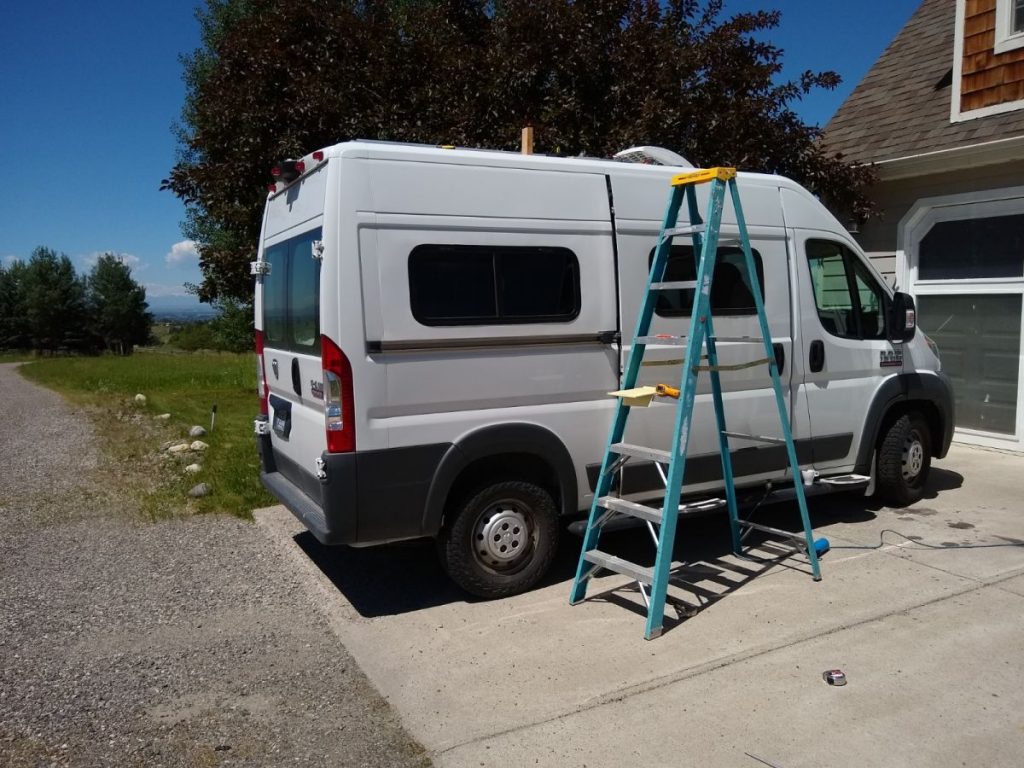
I did several runs, but this one is representative:
- Ambient temperature: 73F
- Full sun: 790 watts/sqmeter on PV panel surface
- Inside van temperature: 78F
- Wind speed: 0 to 4 mph (near calm)
- PV panel top surface temperature: 157F
- Roof temperature under the PV panel: 136F
- Roof temperature outside the PV panel: 119F
So, the roof is about 17 F warmer under the PV panel than away from it. If you were trying to maintain the temperature inside the van at 70F, then the heat gain for the part of the roof under the PV panel would be about 35% greater per sqft than the gain from rest of roof.
This is with a white roof van, as RD pointed out on the forum, the difference would likely be less with a dark roof as the roof runs hotter.
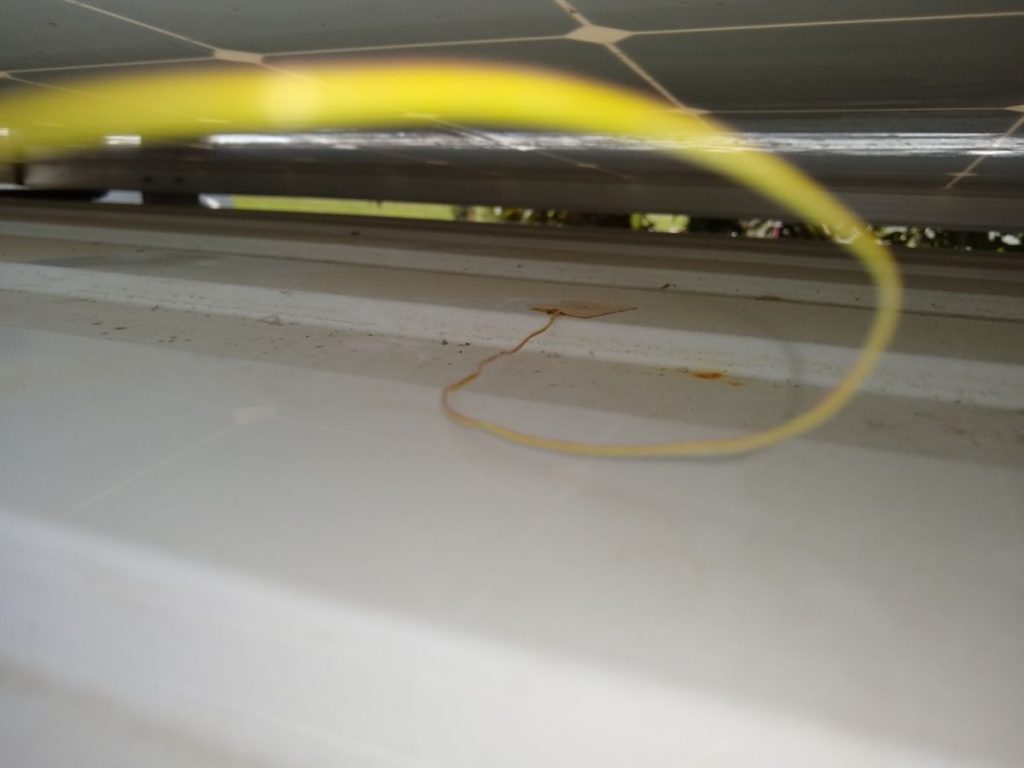
Looking under the PV panel (which has been raised up a bit to get the thermocouple to the middle of it). The surface mount thermocouple is the small patch of tan and has an adhesive coating to make good thermal contact with the van roof.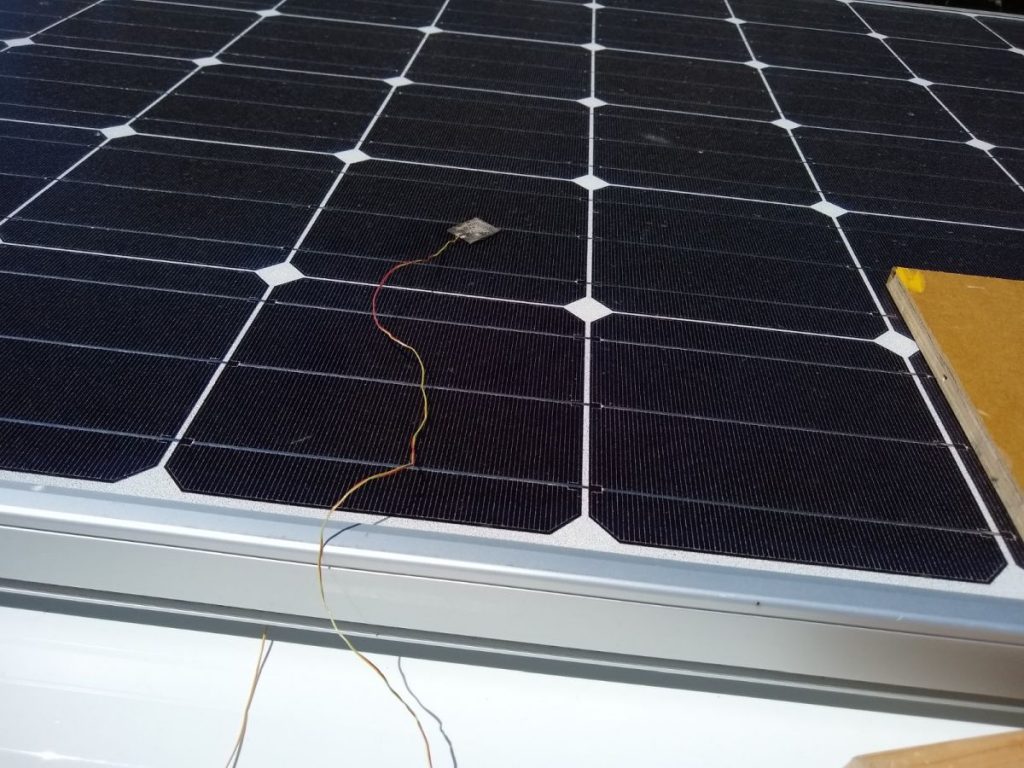 Surface mount thermocouple adhered to top surface of PV panel.
Surface mount thermocouple adhered to top surface of PV panel.

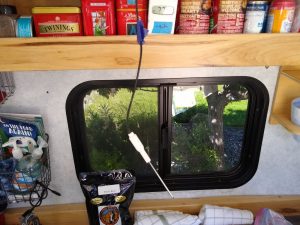
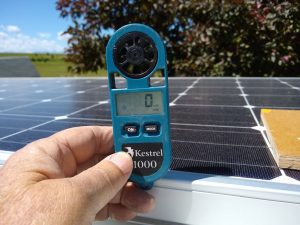
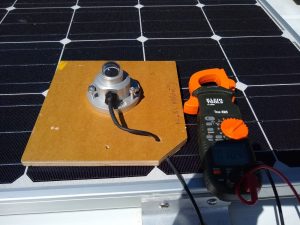
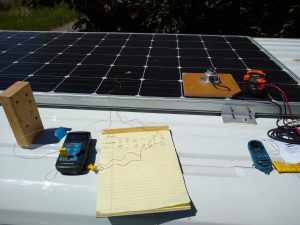
Gary, too late to conduct a test of panel distance vs surface temperature on an operating panel?
Hi Rick,
We woke up to 4 inches of snow this morning, so not anytime soon.
Maybe next summer 🙂
I posted the results on the ProMaster Forum, and some commented that the results appear to vary depending on PV panel to roof distance, roof color and maybe the PV PV panel – can’t remember for sure, but try searching for it on the forum.
Gary
Hi, I have tested my aluminum roof with a 3/4″ spacer under the solar panel frame and my roof is significantly cooler under the solar panel. You put one hand touching the aluminum roof in plain sun and can barely hold your hand , the other hand under the solar panel shade roof is just warm. I will bring an IR thermometer other day and post more accurate data. I could also upload some pics.
1969 Truck Camper, aluminum roof all insulation removed. 365watt Trinasolar 39×77″ solar panel not connected.
Hi,
Interesting!
If the roof is bare aluminum, your IR thermometer won’t give accurate readings on it as its emissivity is quite low compared to a painted surface. You can put a patch of painters tape on it, and then take the IR temperature on the paint.
A picture of the setup would be nice.
Thanks Gary
VERY useful experiment. I also thought the panel would act as “shade” . So do we glue a piece of foamboard insulation to the underside of the panel? Without a gap between the underside of the panel and the aluminum backsheet it won’t act as a radiant barrier…..will it?
Hi,wa
A thin layer of foam insulation on the bottom of the panel would keep the roof cooler, although it will make the PV panel run a little warmer and be a little less efficient. Be sure to use a high temperature foam like Polyiso.
If your PV panel does not have a bare alum sheet on the back, gluing a layer of alum foil to the back of the panel would lower the emissivity of the panel and result in less radiant heat transfer from the PV panel to the roof.
My panel is very close to the roof – I think that raising it some would allow for better air circ under the panel and cooler roof. This may raise the aero drag a bit — I’m not sure.
If you can put more ceiling insulation in. This would dfinitely help reduce heat transfer into the van from the roof.
Gary
Interesting results, I wouldn’t have expected there to be that much radiant heat from the underside of a solar panel. I wonder how much this varies between different manufacturers?
Approximately what is the gap between the bottom of the solar panel and the top of the roof? I suppose creating a larger gap would lower radiant heat transfer but increase drag coefficient. Probably not worth the tradeoff.
I’d still be interested to see the skin temperature differential on the roof surface inside the van under the panel and adjacent to the panel, or to know whether or not you can “spot the solar panel” with a thermal image. With the insulation you have installed I would think the temperature difference would be negligible (i.e. not worth raising the panel and worsening aerodynamic drag) but I bet you’d still be able to spot the solar panel in a thermal image of the roof from inside the van on a sunny day (might have to scale the temp range of the image favorably).
Hi Adam,
The clearance between the pv panel and roof at the center is a bit under 1/4 inch — on the outboard edges, probably more like 1 inch. I tried to get it as close as I could for aero drag.
A rough calc of the difference in in the inside ceiling temperature just based on the R value stackup with the inside static air layer assumed to be R 0.5 would say that the the area under the panel would be 1.2F warmer than the area under the regular roof. Enough to show up on an IR picture, but not huge.
I do plan (someday) to do an MPG test with the solar panel off and on to get an idea on the drag. I’m a huge fan of solar, but I’d really like to know what its costing me in MPG.
Maybe one of the flexible pv panels that could be glued directly to the roof would end up paying its way.
Gary
Hmm. I would have guessed the roof would be cooler under the solar panels since they are in the “shade”. I seems that the black panels heat up enough to offset this. Very interesting, I’m glad you did the experiment.
Tim
I agree with Tim.
Hmm. I would have guessed the roof would be cooler under the solar panels since they are in the “shade”. I seems that the black panels heat up enough to offset this. Very interesting, I’m glad you did the experiment.
Tim
The PV panels shown above don’t have an aluminum backsheet, which serves as a radiant barrier (and which can also be added as part of the installation).
Some of the additional heat absorbed by the almost-black exposed PV panel surface is conveyed (mostly as radiant heat) downward onto the white vehicle roof, which if exposed has a much higher solar reflective index than the PV panel itself.